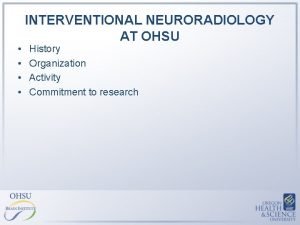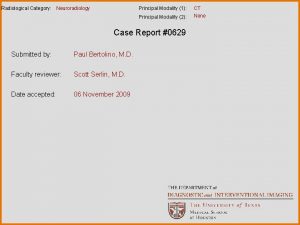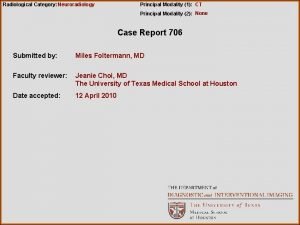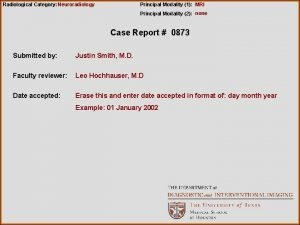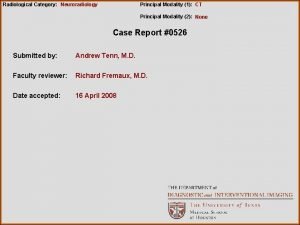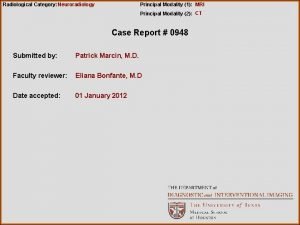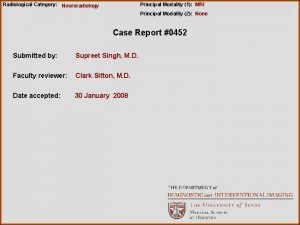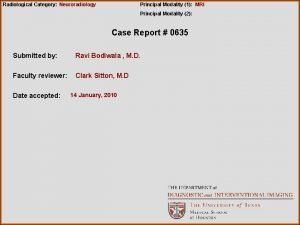Radiological Category Neuroradiology Principal Modality 1 Principal Modality









- Slides: 9

Radiological Category: Neuroradiology Principal Modality (1): Principal Modality (2): Case Report #0630 Submitted by: Paul Bertolino, M. D. Faculty reviewer: Eliana Bonfante, M. D. Date accepted: 10 November 2009 MR none

Case History A two year old boy that presented with weakness. The patient began having feeding difficulties, specifically when chewing. Mastication had become progressively weaker. The patient was born at term without complications. Early development was normal. The patient began to talk at one year, but stopped talking at a year and a half. He stood at ten months, but stopped standing at about one year of age.

Radiological Presentations

Test Your Diagnosis Which one of the following is your choice for the appropriate diagnosis? After your selection, go to next page. • Adrenoleukodystrophy • Krabbe’s Disease • Metachromatic Leukodystrophy • Hurler’s

Findings and Differentials Findings: Increased T 2 signal in the centrum semiovale bilaterally and pons. Differentials: • Adrenoleukodystrophy • Krabbe’s Disease • Metachromatic Leukodystrophy • Hurler’s

Discussion Adrenoleukodystrophy is caused by an enzyme deficiency which affects the white matter of the CNS, adrenal cortex, and testes. Fatty acids build up because of the enzyme deficiency. Early in the disease demyelination occurs in the peritrigonal region, extending across the splenium of the corpus callosum. The white matter changes then extend anteriorly. The central area of involvement is hypointense on T 1 and hyperintense on T 2, which also happens to be the signal of unmyelinated white matter. An intermediate zone demonstrates enhancement with gadolinium administration. And the most peripheral edge is usually T 2 hyperintense, without enhancement. Increased T 2 signal is seen along the descending pyramidal tract. Krabbe’s Disease is caused by another enzyme deficiency, leading to accumulation of cerebrosides once myelin turnover begins. Diagnosis is made by detecting the enzyme deficiency in peripheral leukocytes. Young patients may present with hyperirritability, increased muscle tone, fever, developmental arrest/regression. T 2 weighted imaging demonstrates increased signal in the centrum semiovale, periventricular white matter, deep grey matter, and possibly pyramidal tract and cerebellum. Severe atrophy occurs as disease progresses.

Discussion Metachromatic leukodystrophy is yet another disorder caused by an enzyme deficiency. Because of the enzyme deficiency, sulfatides accumulate in various tissues including brain, peripheral nerves, kidneys, liver and gallbladder. Patients present with deterioration of intellect, speech, and coordination. Neuromuscular deterioration occurs within 2 years of diagnosis. Confluent areas of T 2 signal hyperintensity are seen in the periventricular white matter with sparing of the subcortical U fibers. The corticospinal tracts, corpus callosum, and internal capsule are also frequently involved. Hurler’s Disease is a mucopolysaccharidosis, which is a group of disorders caused by a deficiency in one of the enzymes responsible for degradation of glycosaminoglycans. Imaging reveals delayed myelination, atrophy, hydrocephalus, and white matter changes. MR demonstrates focal areas of signal abnormality that are nearly isointense to CSF on T 1 and T 2. As the disease progresses, the lesions become larger and more diffuse.

Diagnosis Genetic analysis confirmed the diagnosis of Krabbe’s disease.

References Cheon, Kim, Hwang, Kim, Wang, Cho, Chi, Kim, Yeon. Leukodystrophy in Children: A Pictorial Review of MR Imaging Features; Radiographics 2002; 22: 461 -476. Phelan, Lowe, Glasier. Pediatric Neurodegenerative White Matter Processes: Leukodystrophies and Beyond; Pediatric Radiology 2008; 38: 729 -749.
